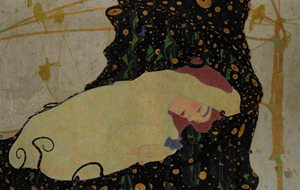
Painted in 1909, Danaë is Egon Schiele’s greatest early masterpiece. It contains the first flowering of Schiele's unique vision and voice.
Painted in 1909, Danaë is Egon Schiele’s greatest early masterpiece. It contains the first flowering of Schiele's unique vision and voice. The jewel-like surface, the geometrical patterning and the broad expanses of color in the present work epitomize the lavishness and opulence of the Jugenstil decorative tradition. Here, Schiele focuses his great talent for figuration on Danaë’s hand, shoulder blade and right arm as well as the supreme delicacy of the figure’s facial features. His subtle usage of varied coloration in her flesh contrasts sharply with the gold, green and black shower of Zeus. The mythological roots of the subject matter in the present work serve as a perfect backdrop for the highly stylized execution and ambiguous space, while also allowing for a free use of the nude as subject matter.
Greek mythology, adapted and recounted in Latin in the verses of Ovid’s Metamorphoses, relates how the beautiful Danaë was locked away in a bronze tower by her father, King Acrisius of Argos. Disappointed that he and his wife Eurydice had not produced a male heir, Acrisius consulted an oracle, who informed him that his daughter’s son would kill him. In order to keep her childless, the king banished Danaë to a tower, away from the reach of men. While no mortal could gain access to Danaë, her imprisonment was no obstacle to Zeus and his insatiable desire for young maidens. Transforming himself into a shower of golden rain, Zeus lay with Danaë and impregnated her, conceiving the boy who would become the hero Perseus, famed for killing the Medusa and for rescuing Andromeda. When Perseus was born, Acrisius threw both mother and son out to sea in a wooden chest, but Poseidon, the sea god, calmed the choppy waters and saved them. Later in life Perseus would indeed kill Acrisius, thereby affirming the inescapability of fate. A theme found equally in Greek vase painting, monumental canvases of the Old Masters from Gentileschi to Titian and the stunning marble carving of Auguste Rodin in the late nineteenth-century, the legends of Zeus and his many mortal conquests provided ripe subject matter for the nude in art.
Danaë was created when Schiele was only nineteen years old. While he entered the Academy of Fine Arts in Vienna in 1906, his stay would be relatively short lived. Rebelling against the Ringstrasse Style of his instructors, and with several of his works chosen for public exhibition (prohibited to students at the Academy of Fine Arts) by Gustav Klimt, Schiele broke with his teachers and established the Neuekunstgruppe (New Art Group) with other young visual and performing artists. His rebellion echoed that of the initial formation of the Viennese Secession in 1897 which in turn had gone through its own internal schism in 1905. Klimt, at this time the most famous visual artist in Vienna, left and formed the “Klimtgruppe.” It was in this atmosphere, bubbling with tensions and disagreements within and amongst the traditional and avant garde artists groups, that the teenage Egon Schiele came of age.

ArtDependence Magazine is an international magazine covering all spheres of contemporary art, as well as modern and classical art.
ArtDependence features the latest art news, highlighting interviews with today’s most influential artists, galleries, curators, collectors, fair directors and individuals at the axis of the arts.
The magazine also covers series of articles and reviews on critical art events, new publications and other foremost happenings in the art world.
If you would like to submit events or editorial content to ArtDependence Magazine, please feel free to reach the magazine via the contact page.